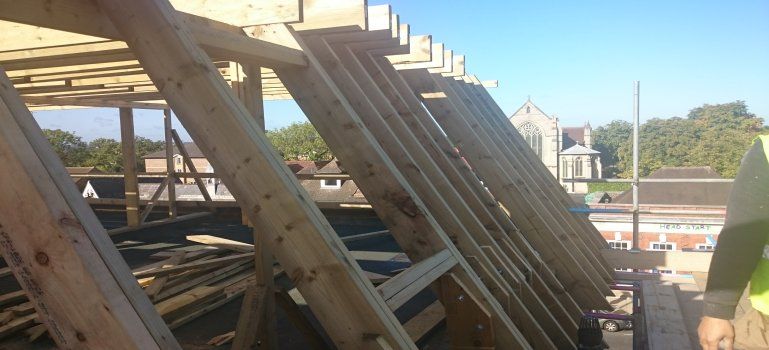How Structural Design Can Save 50% of the Cost of Your Roof Extension

In construction, you very rarely pay attention to the challenges of structural design. The cost, complexity and schedule of construction projects are deeply impacted by the structural elements and their design. It is possible to create alternative structural designs that address budget and complexity issues as well as space, light and habitability. As the word design suggests, creating supporting structures for buildings is a creative exercise.
How to add a storey to a 1970 three-storey building in Central London
The building has external load-bearing brick walls, 3 storeys with suspended timber floor and a middle spiral wall. The width of the structure was 12 meters and the length was 21 meters.
Weight, size, transport, access: the challenges of a traditional steel structure
The main challenge is to create the optimal design for the additional floor. The most obvious solution would use very long and large steel beams because of the long span of the structure. Creating a structural frame in timber, we saved our client money and time and make the installation easier, compared to the equivalent of the steel structure.
THE WEIGHT OF STEEL VS THE WEIGHT OF TIMBER
Steel adds a massive weight load to the existing structure, causing additional stress to the building; it might also require strengthening of the foundations and internal load bearing walls. Timber is much lighter so that no alteration to the foundations is required in this case. Because of the lower weight, it is also easier to transport, handle and install.
INSTALLING LONG STEEL BEAMS VS INSTALLING SHORTER TIMBER BEAMS
long steel beams are difficult to transport and install and need special equipment to be lifted and put in place, often requiring permissions from the council to block roads and pavements. They also need specific health and safety measures during the installation. The timber structure has shorter and lighter elements so that no additional measure is needed for transportation and the installation procedure is simpler.
THE COST OF STEEL VS THE COST OF TIMBER, INCLUDING DELIVERY AND TRANSPORT TO THE TOP FLOOR
steel is an expensive material, even more when we include the management of the installation operations. With timber, all the costs due to the usage of steel were eliminated or lowered.
HOW TO DESIGN A TIMBER STRUCTURE SO THAT IT IS EQUIVALENT TO A STEEL ONE?
With the timber design, we could exploit the added flexibility, distributing part of the weight of the flat roof on the internal walls of the new storey and consequently on the internal walls of all the storeys below. This would not be possible with a steel structure because the internal walls were not strong enough to bear the load of the steel frame.
To use timber, we designed special connections between the mansard rafters and the flat roof joists, so to make sure that the load was distributed correctly. We transferred half of the load of the timber joists to the rafters and then from the wall plate to the external load-bearing brick walls. We designed the connections between the joists and the rafters to transfer the vertical load, shear and bending moment from the flat roof to the mansard walls. We also used 2 extra pieces of timber bolted together with M12 bolts connecting the roof joists with the mansard rafters and the latter with the wall plate of the external wall. To compensate lateral forces, we connected all the timber rafters and joists with plywood sheets, so that the structure was stable and could restrain wind forces.
WHAT ARE THE TANGIBLE BENEFITS OF THE TIMBER STRUCTURE?
Using timber, we were adding less weight, as the timber structure would be much lighter than the steel one. A rough estimate is that the total weight of the timber structure was 20% of the equivalent steel one. The timber structure allowed a more even distribution of the load onto the existing building. We created better load paths with our design concept, also thanks to the higher flexibility of the timber material . The higher flexibility of the timber material also meant that timber was easier to transport and install, and the operations were less error prone than the ones involving steel. The handling of shorter and lighter joists was less complex and could be done by fewer people at a time. Plus, timber is less expensive in itself, so our client saved roughly 30% of the cost of the material for the structure. Finally, we must consider the savings in transportation and installation. We estimate the timber structure saved 50% of the cost compared to the equivalent steel one.
WHY WAS ALL THAT IMPORTANT FOR OUR CLIENT’S SATISFACTION?
Using the timber structure we completed the project earlier because we built the structure more quickly. Our quotation was more convenient for the client because we had lower contingency rates. We mitigated the risks of a steel structure using a timber design. The savings were even higher because of the lower costs of materials and installation. Overall, our client saved money in many different ways. We saved them time, cost of material, labour, equipment and finally contingency cost.
Gen is managing director and chief of digital strategy at houseUP. She has a background in information security and product management in tech startups.
houseUP is a construction company in London, specialised in high end residential and commercial projects.

